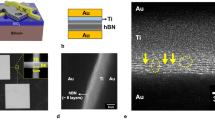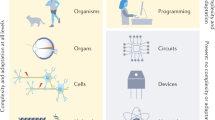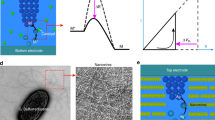Abstract
Anyone who ever took an electronics laboratory class will be familiar with the fundamental passive circuit elements: the resistor, the capacitor and the inductor. However, in 1971 Leon Chua reasoned from symmetry arguments that there should be a fourth fundamental element, which he called a memristor (short for memory resistor)1. Although he showed that such an element has many interesting and valuable circuit properties, until now no one has presented either a useful physical model or an example of a memristor. Here we show, using a simple analytical example, that memristance arises naturally in nanoscale systems in which solid-state electronic and ionic transport are coupled under an external bias voltage. These results serve as the foundation for understanding a wide range of hysteretic current–voltage behaviour observed in many nanoscale electronic devices2,3,4,5,6,7,8,9,10,11,12,13,14,15,16,17,18,19 that involve the motion of charged atomic or molecular species, in particular certain titanium dioxide cross-point switches20,21,22.
This is a preview of subscription content, access via your institution
Access options
Subscribe to this journal
Receive 51 print issues and online access
$199.00 per year
only $3.90 per issue
Buy this article
- Purchase on Springer Link
- Instant access to full article PDF
Prices may be subject to local taxes which are calculated during checkout



Similar content being viewed by others
References
Chua, L. O. Memristor - the missing circuit element. IEEE Trans. Circuit Theory 18, 507–519 (1971)
Hickmott, M. T. Low-frequency negative resistance in thin anodic oxide films. J. Appl. Phys. 33, 2669–2682 (1962)
Dearnaley, G., Stoneham, A. M. & Morgan, D. V. Electrical phenomena in amorphous oxide films. Rep. Prog. Phys. 33, 1129–1192 (1970)
Waser, R. & Aono, M. Nanoionics-based resistive switching memories. Nature Mater. 6, 833–840 (2007)
Scott, J. C. & Bozano, L. D. Nonvolatile memory elements based on organic materials. Adv. Mater. 19, 1452–1463 (2007)
Collier, C. P. et al. A [2]catenane-based solid state electronically reconfigurable switch. Science 289, 1172–1175 (2000)
Zhitenev, N. B., Sidorenko, A., Tennant, D. M. & Cirelli, R. A. Chemical modification of the electronic conducting states in polymer nanodevices. Nature Nanotechnol. 2, 237–242 (2007)
Smits, J. H. A., Meskers, S. C. J., Janssen, R. A. J., Marsman, A. W. & de Leeuw, D. M. Electrically rewritable memory cells from poly(3-hexylthiophene) Schottky diodes. Adv. Mater. 17, 1169–1173 (2005)
Lai, Q. X., Zhu, Z. H., Chen, Y., Patil, S. & Wudl, F. Organic nonvolatile memory by dopant-configurable polymer. Appl. Phys. Lett. 88, 133515 (2006)
Terabe, K., Hasegawa, T., Nakayama, T. & Aono, M. Quantized conductance atomic switch. Nature 433, 47–50 (2005)
Kozicki, M. N., Park, M. & Mitkova, M. Nanoscale memory elements based on solid-state electrolytes. IEEE Trans. Nanotechnol. 4, 331–338 (2005)
Dietrich, S. et al. A nonvolatile 2-Mbit CBRAM memory core featuring advanced read and program control. IEEE J. Solid State Circuits 42, 839–845 (2007)
Jameson, J. R. et al. Field-programmable rectification in rutile TiO2 crystals. Appl. Phys. Lett. 91, 112101 (2007)
Jeong, D. S., Schroeder, H. & Waser, R. Coexistence of bipolar and unipolar resistive switching behaviors in a Pt/TiO2/Pt stack. Electrochem. Solid State Lett. 10, G51–G53 (2007)
Beck, A., Bednorz, J. G., Gerber, C., Rossel, C. & Widmer, D. Reproducible switching effect in thin oxide films for memory applications. Appl. Phys. Lett. 77, 139–141 (2000)
Szot, K., Speier, W., Bihlmayer, G. & Waser, R. Switching the electrical resistance of individual dislocations in single-crystalline SrTiO3 . Nature Mater. 5, 312–320 (2006)
Sawa, A., Fujii, T., Kawasaki, M. & Tokura, Y. Interface resistance switching at a few nanometer thick perovskite manganite active layers. Appl. Phys. Lett. 88, 232112 (2006)
Hamaguchi, M., Aoyama, K., Asanuma, S., Uesu, Y. & Katsufuji, T. Electric-field-induced resistance switching universally observed in transition-metal-oxide thin films. Appl. Phys. Lett. 88, 142508 (2006)
Oligschlaeger, R., Waser, R., Meyer, R., Karthauser, S. & Dittmann, R. Resistive switching and data reliability of epitaxial (Ba,Sr)TiO3 thin films. Appl. Phys. Lett. 88, 042901 (2006)
Richter, C. A., Stewart, D. R., Ohlberg, D. A. A. & Williams, R. S. Electrical characterization of Al/AlO x /molecule/Ti/Al devices. Appl. Phys. Mater. Sci. Process. 80, 1355–1362 (2005)
Stewart, D. R. et al. Molecule-independent electrical switching in Pt/organic monolayer/Ti devices. Nano Lett. 4, 133–136 (2004)
Blackstock, J. J., Stickle, W. F., Donley, C. L., Stewart, D. R. & Williams, R. S. Internal structure of a molecular junction device: chemical reduction of PtO2 by Ti evaporation onto an interceding organic monolayer. J. Phys. Chem. C 111, 16–20 (2007)
Chua, L. O. & Kang, S. M. Memristive devices and systems. Proc. IEEE 64, 209–223 (1976)
Kuekes, P. J., Snider, G. S. & Williams, R. S. Crossbar nanocomputers. Sci. Am. 293, 72–78 (2005)
Strukov, D. B. & Likharev, K. K. Defect-tolerant architectures for nanoelectronic crossbar memories. J. Nanosci. Nanotechnol. 7, 151–167 (2007)
Blanc, J. & Staebler, D. L. Electrocoloration in SrTiO - vacancy drift and oxidation-reduction of transition metals. Phys. Rev. B 4, 3548–3557 (1971)
Acknowledgements
This research was conducted with partial support from DARPA and DTO.
Author information
Authors and Affiliations
Corresponding author
Rights and permissions
About this article
Cite this article
Strukov, D., Snider, G., Stewart, D. et al. The missing memristor found. Nature 453, 80–83 (2008). https://doi.org/10.1038/nature06932
Received:
Accepted:
Issue Date:
DOI: https://doi.org/10.1038/nature06932
This article is cited by
-
High-speed and energy-efficient non-volatile silicon photonic memory based on heterogeneously integrated memresonator
Nature Communications (2024)
-
Elementary cellular automata realized by stateful three-memristor logic operations
Scientific Reports (2024)
-
High-order sensory processing nanocircuit based on coupled VO2 oscillators
Nature Communications (2024)
-
Potential and challenges of computing with molecular materials
Nature Materials (2024)
-
A general discrete memristor emulator based on Taylor expansion for the reconfigurable FPGA implementation and its application
Nonlinear Dynamics (2024)
Comments
By submitting a comment you agree to abide by our Terms and Community Guidelines. If you find something abusive or that does not comply with our terms or guidelines please flag it as inappropriate.



